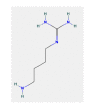Neuroprotective Role of Agmatine in Neurological Diseases
- PMID: 28786346
- PMCID: PMC6251039
- DOI: 10.2174/1570159X15666170808120633
Neuroprotective Role of Agmatine in Neurological Diseases
Abstract
Background: Neurological diseases have always been one of the leading cause of mobility and mortality world-widely. However, it is still lacking efficient agents. Agmatine, an endogenous polyamine, exerts its diverse biological characteristics and therapeutic potential in varied aspects.
Methods: This review would focus on the neuroprotective actions of agmatine and its potential mechanisms in the setting of neurological diseases.
Results: Numerous studies had demonstrated the neuroprotective effect of agmatine in varied types of neurological diseases, including acute attack (stroke and trauma brain injury) and chronic neurodegenerative diseases (Parkinson's disease, Alzheimer's disease). The potential mechanism of agmatine induced neuroprotection includes anti-oxidation, anti-apoptosis, anti-inflammation, brain blood barrier (BBB) protection and brain edema prevention.
Conclusions: The safety and low incidence of adverse effects indicate the vast potential therapeutic value of agmatine in the treatment of neurological diseases. However, most of the available studies relate to the agmatine are conducted in experimental models, more clinical trials are needed before the agmatine could be extensively clinically used.
Keywords: Agmatine; chronic neurodegenerative diseases; mechanism; neurological diseases; neuroprotective effect; stroke..
Copyright© Bentham Science Publishers; For any queries, please email at epub@benthamscience.org.
Figures
Similar articles
-
Role of agmatine in neurodegenerative diseases and epilepsy.Front Biosci (Elite Ed). 2014 Jun 1;6(2):341-59. doi: 10.2741/E710. Front Biosci (Elite Ed). 2014. PMID: 24896210 Review.
-
Therapeutic Effect of Agmatine on Neurological Disease: Focus on Ion Channels and Receptors.Neurochem Res. 2019 Apr;44(4):735-750. doi: 10.1007/s11064-018-02712-1. Epub 2019 Jan 4. Neurochem Res. 2019. PMID: 30610652 Review.
-
Neuroprotective effect of agmatine (decarboxylated l-arginine) against oxidative stress and neuroinflammation in rotenone model of Parkinson's disease.Hum Exp Toxicol. 2019 Feb;38(2):173-184. doi: 10.1177/0960327118788139. Epub 2018 Jul 13. Hum Exp Toxicol. 2019. PMID: 30001633
-
Therapeutic potential of agmatine for CNS disorders.Neurochem Int. 2017 Sep;108:318-331. doi: 10.1016/j.neuint.2017.05.006. Epub 2017 May 15. Neurochem Int. 2017. PMID: 28522414 Review.
-
Neuroprotective offerings by agmatine.Neurotoxicology. 2019 Jul;73:228-245. doi: 10.1016/j.neuro.2019.05.001. Epub 2019 May 4. Neurotoxicology. 2019. PMID: 31063707 Review.
Cited by
-
Effect of Chronic Dolutegravir Administration on the Trace Amine Profile in Wistar Rats.Drugs R D. 2024 Sep;24(3):435-445. doi: 10.1007/s40268-024-00484-4. Epub 2024 Aug 23. Drugs R D. 2024. PMID: 39177936 Free PMC article.
-
Acid-sensing ion channel 3 is required for agmatine-induced histamine-independent itch in mice.Front Mol Neurosci. 2023 Mar 1;16:1086285. doi: 10.3389/fnmol.2023.1086285. eCollection 2023. Front Mol Neurosci. 2023. PMID: 36937045 Free PMC article.
-
Role of agmatine in the application of neural progenitor cell in central nervous system diseases: therapeutic potentials and effects.Anat Cell Biol. 2021 Jun 30;54(2):143-151. doi: 10.5115/acb.21.089. Anat Cell Biol. 2021. PMID: 34162764 Free PMC article. Review.
-
Oligodendrocyte Progenitors in Glial Scar: A Bet on Remyelination.Cells. 2024 Jun 12;13(12):1024. doi: 10.3390/cells13121024. Cells. 2024. PMID: 38920654 Free PMC article. Review.
-
Evidence for Dietary Agmatine Sulfate Effectiveness in Neuropathies Associated with Painful Small Fiber Neuropathy. A Pilot Open-Label Consecutive Case Series Study.Nutrients. 2020 Feb 23;12(2):576. doi: 10.3390/nu12020576. Nutrients. 2020. PMID: 32102167 Free PMC article. Clinical Trial.
References
-
- Yi B.R., Kim S.U., Choi K.C. Development and application of neural stem cells for treating various human neurological diseases in animal models. Lab. Anim. Res. 2013;29(3):131–137. [http:// dx.doi.org/10.5625/lar.2013.29.3.131]. [PMID: 24106507]. - PMC - PubMed
-
- Xu X.H., Zhong Z. Disease modeling and drug screening for neurological diseases using human induced pluripotent stem cells. Acta Pharmacol. Sin. 2013;34(6):755–764. [http://dx.doi.org/ 10.1038/aps.2013.63]. [PMID: 23685955]. - PMC - PubMed
-
- Kim J.H., Yenari M.A., Giffard R.G., Cho S.W., Park K.A., Lee J.E. Agmatine reduces infarct area in a mouse model of transient focal cerebral ischemia and protects cultured neurons from ischemia-like injury. Exp. Neurol. 2004;189(1):122–130. [http:// dx.doi.org/10.1016/j.expneurol.2004.05.029]. [PMID: 15296842]. - PubMed
-
- Gilad G.M., Gilad V.H., Finberg J.P., Rabey J.M.
Publication types
MeSH terms
Substances
LinkOut - more resources
Full Text Sources
Other Literature Sources
Medical


